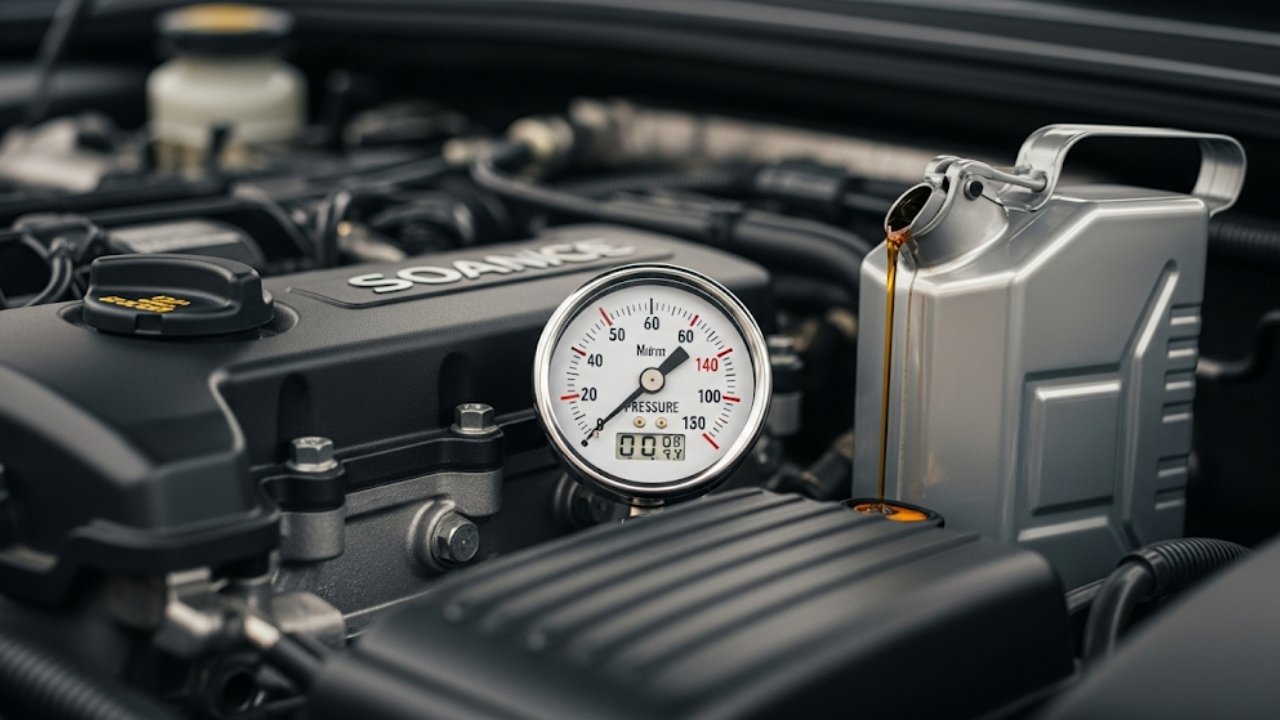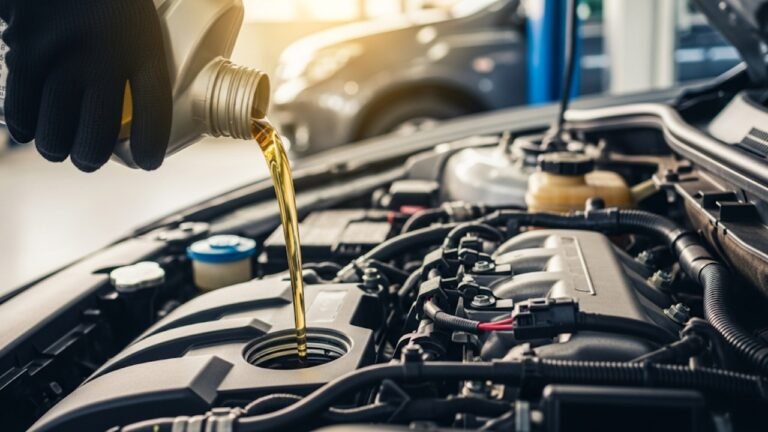What Causes Low Oil Pressure in a Car?

You’re driving along, music playing, windows down, and then ding!—that dreaded low oil pressure light flickers on. Your heart skips a beat. “What now?” you mutter, pulling over, hoping it’s just a glitch. Sadly, it’s often not. Low oil pressure in a car isn’t just some minor hiccup. It’s your car crying out for help.
Think of engine oil like the blood in your veins. Without enough of it—or if it’s not flowing properly—things can go sideways fast. Your engine parts grind. Friction builds. Metal meets metal. And the damage? Expensive, sometimes irreversible.
But before we panic, let’s break it all down. From clogged oil filters to worn-out pumps, what causes low oil pressure in a car often hides in the little details. And understanding those details? That’s how you stay in control.
In This Article
- 1 The Oil Pressure Basics You Need to Know
- 2 ️ Not Enough Oil? That’s Where It Often Begins
- 3 Old, Thin, or Dirty Oil Can’t Keep Up
- 4 ⚙️ Faulty Oil Pump = Pressure Drop Disaster
- 5 ️ Clogged or Broken Oil Filter
- 6 Oil Pressure Sensor Isn’t Always Right
- 7 Worn Engine Bearings = Low Pressure Over Time
- 8 Oil Viscosity That’s Too Low
- 9 Internal Oil Leaks You Can’t See
- 10 Cracked or Clogged Oil Pickup Tube
- 11 Quick Comparison: Common Causes of Low Oil Pressure
- 12 Pro Tips to Prevent Low Oil Pressure
- 13 ❓ FAQs: What Causes Low Oil Pressure in a Car
- 13.1 1. Can I drive with low oil pressure?
- 13.2 2. How do I know if the oil pressure sensor is faulty?
- 13.3 3. Will an oil change fix low pressure?
- 13.4 4. What oil should I use to avoid low pressure?
- 13.5 5. Why does my oil light come on only when idling?
- 13.6 6. Does synthetic oil cause low pressure?
- 13.7 7. Can cold weather cause low oil pressure?
- 13.8 8. Is oil pressure the same as oil level?
- 14 Wrapping It Up: Don’t Ignore the Warning Signs
The Oil Pressure Basics You Need to Know

So what creates oil pressure in the first place?
A small but mighty tool called the oil pump. It draws oil from the pan and pushes it through the engine. The pump’s strength and the oil’s thickness (or viscosity) work together to create stable pressure.
But if something disrupts this flow—say a leak, a bad pump, or low oil level—that pressure drops. And your dashboard light becomes your worst enemy.
Key Symptoms of Low Oil Pressure:
-
Flickering or solid oil warning light
-
Engine ticking or knocking
-
Loss of power
-
Engine overheating
-
Burning oil smell
️ Not Enough Oil? That’s Where It Often Begins
Let’s start with the obvious. One of the most common causes of low oil pressure in a car is, quite simply, not having enough oil.
Life gets busy. Oil checks fall by the wayside. And before you know it, your engine’s running dry. This is especially true in older cars that naturally burn more oil over time.
Why You Might Have Low Oil Levels:
-
You forgot to check or top up your oil
-
Your car is leaking oil (look for dark spots under your car)
-
The engine is burning oil internally
-
The oil filter was installed wrong or is faulty
-
You got an oil change, but not enough oil was added
Here’s a helpful table to show how low oil levels affect pressure:
| Oil Level | Oil Pressure Behavior | What to Watch For |
|---|---|---|
| Full | Stable and optimal pressure | No issues |
| Slightly Low | Mild drop in pressure | Occasional light flicker |
| Very Low | Significant pressure loss | Ticking noises, dashboard light |
| Critically Low | Dangerously low pressure | Risk of engine damage |
Moral of the story? Check your oil regularly. It takes two minutes and could save you thousands in repairs. I learned this the hard way when my old Corolla started knocking on the highway—it hadn’t had an oil top-up in months. I was lucky the engine didn’t seize completely.
Old, Thin, or Dirty Oil Can’t Keep Up
Now, let’s talk about oil itself. Even if you have the right amount, oil that’s too thin, too old, or sludgy won’t do its job well. When oil breaks down, it loses viscosity. Think of it like running water instead of honey through your engine—too thin to cushion anything.
Also, as oil ages, it collects dirt, carbon, and even metal shavings. That gunk turns into sludge. Sludge clogs the small oil passages that the pump relies on to circulate pressure properly.
Common Oil Problems That Lower Pressure:
-
Using the wrong grade oil (check your manual!)
-
Oil hasn’t been changed in 5,000–10,000 miles
-
Engine overheating breaks oil down
-
Driving in extreme cold or heat
-
Short trips that don’t warm up the engine fully
Using cheap or generic oil once to save a few bucks might seem harmless, but over time, your engine will pay the price. I once used bargain oil during a road trip. Within weeks, my oil light started flashing during idle. Changed the oil with the right grade—and problem solved.
⚙️ Faulty Oil Pump = Pressure Drop Disaster
Your engine’s oil pump is the unsung hero working 24/7 under your hood. If it fails, pressure plummets—fast. This is one of the scarier causes of low oil pressure in a car because it usually leads to severe damage unless caught early.
When the pump isn’t working properly, it can’t pull in or push out oil fast enough. That means some parts of your engine aren’t getting the lubrication they need. Cue the knocking sounds, rough idling, and eventually… engine failure.
Signs of a Failing Oil Pump:
-
Low oil pressure light stays on
-
Strange ticking or whining sounds from the engine
-
Loss of acceleration power
-
High engine temperature
Replacing a worn-out oil pump isn’t cheap, but ignoring it costs way more. Some mechanics call it the “silent killer” because many drivers don’t even know it’s failing until the engine’s already damaged.
️ Clogged or Broken Oil Filter
The oil filter is like your engine’s liver—it removes toxins and keeps everything running smooth. But when it gets clogged or damaged, pressure builds up in the wrong places or drops dangerously low.
In some cases, a clogged filter will trigger the bypass valve, which allows unfiltered oil to keep moving. But that’s just a temporary fix. You could end up with debris cycling through your engine—and pressure readings all over the place.
Why Filters Get Clogged:
-
Missed oil change intervals
-
Excess sludge or carbon in old engines
-
Faulty or low-quality filters
-
Wrong installation or loose fittings
Pro tip: Always change the oil filter with your oil. It’s a cheap part, and your engine will thank you for it.
Oil Pressure Sensor Isn’t Always Right
Sometimes the problem isn’t actually a problem. The oil pressure sensor (also called the sending unit) can fail and give false readings. That means your dash might be screaming low oil pressure! when everything’s actually fine.
Signs of a Faulty Sensor:
-
Light comes on but pressure tests okay
-
No other symptoms like noise or overheating
-
Light flickers randomly, especially at idle
If in doubt, get a mechanic to use a mechanical oil pressure gauge. That’s the most accurate way to check what’s really going on inside your engine. I’ve had this happen before—light came on during a drive, pulled over, checked the oil, all good. Turned out the sensor had corroded. A $40 fix saved a lot of worry.
Worn Engine Bearings = Low Pressure Over Time
Here’s where it gets a bit more technical. Your engine has bearings—tiny metal parts that cushion moving engine components like the crankshaft and camshaft. Over time, those bearings can wear out. When they do, they create more space in the oil passages.
The result? Oil flows too easily and doesn’t build enough pressure. It’s like trying to inflate a tire with a huge hole in it. Pressure just can’t build.
This issue is more common in high-mileage vehicles and engines that haven’t been properly maintained. And once bearings are worn, the only fix is a serious repair job.
Oil Viscosity That’s Too Low
Not all oil is created equal. If you’ve ever tried using cooking oil instead of motor oil (please don’t!), you know viscosity matters. Oil viscosity refers to how thick or thin the oil is. It directly affects how well it builds pressure and protects engine components.
If the oil is too thin, it slips through the system too easily and can’t generate proper pressure. In cold weather, oil naturally thins out, which is why many cars need different oil types in winter vs. summer.
What Causes Low Viscosity Issues:
-
Using the wrong oil for your climate or engine
-
Oil has broken down from heat and mileage
-
Over-thinning from fuel dilution
-
Adding additives that reduce oil thickness
Always use the oil grade recommended in your owner’s manual. For most cars, that’s 5W-30 or 10W-40, but high-performance engines might need something thicker.
Internal Oil Leaks You Can’t See
Most of us look under the car for oil leaks. But not all leaks leave puddles. Some happen inside the engine, especially when seals or gaskets fail. The oil ends up where it shouldn’t—burned in the combustion chamber or lost inside the engine block.
These internal oil leaks are sneaky. You may not even notice them at first. But over time, your oil level drops, your pressure drops, and your engine slowly suffocates.
Common Internal Leak Locations:
-
Valve seals
-
Head gaskets
-
Turbochargers
-
PCV system failures
If you’re losing oil but don’t see a leak, this could be the reason. A mechanic can use a dye test or bore scope to find the problem.
Cracked or Clogged Oil Pickup Tube
Your engine’s oil pump doesn’t just magically collect oil. It uses a pickup tube, which sucks oil from the pan. If that tube gets cracked, bent, or clogged with debris, the pump can’t do its job. That’s another hidden cause of low oil pressure in a car.
This problem often arises in engines that haven’t been cleaned or maintained. Sludge builds up in the pan, chunks break off, and the pickup screen gets blocked. No oil = no pressure.
It’s rare but serious. If you suspect this, your mechanic may need to remove the oil pan and clean it out.
Quick Comparison: Common Causes of Low Oil Pressure
Here’s a side-by-side look at the most common culprits behind oil pressure problems and how to recognize them:
| Cause | Symptoms | Risk Level | DIY Fixable? |
|---|---|---|---|
| Low Oil Level | Light on dash, ticking noise | High | ✅ Yes |
| Old/Dirty Oil | Sludge, overheating, pressure drops | Moderate | ✅ Yes |
| Wrong Viscosity | Light flickers in cold/hot weather | Moderate | ✅ Yes |
| Faulty Oil Pump | Noise, overheating, major pressure loss | Severe | ❌ No |
| Clogged Oil Filter | Random drops in pressure | Moderate | ✅ Yes |
| Faulty Sensor | False warnings, light flickering | Low | ✅ Yes |
| Internal Leak | Oil loss, burning smell, no external leak | High | ❌ No |
| Worn Bearings | Gradual loss of pressure, engine knocking | Severe | ❌ No |
Pro Tips to Prevent Low Oil Pressure
You don’t need to be a mechanic to keep your oil pressure happy. A few simple habits can save your engine’s life.
Keep These Tips in Mind:
-
✅ Check oil level every 2–3 weeks
-
✅ Change your oil every 3,000–5,000 miles (or as recommended)
-
✅ Use quality oil of the correct viscosity grade
-
✅ Replace the oil filter with every oil change
-
✅ Watch for warning signs like ticking, overheating, or loss of power
-
✅ Get your oil pressure sensor checked if the light flickers randomly
-
✅ Don’t ignore burning smells or vanishing oil
❓ FAQs: What Causes Low Oil Pressure in a Car
1. Can I drive with low oil pressure?
No, and I mean it. Driving with low oil pressure can destroy your engine within minutes. Pull over, turn off the engine, and check the oil level immediately.
2. How do I know if the oil pressure sensor is faulty?
If your oil light is on but everything else seems normal—no knocking, no overheating—it could be a bad sensor. A mechanic can confirm this with a pressure test.
3. Will an oil change fix low pressure?
Sometimes, yes. If dirty oil or a clogged filter is the problem, an oil change will restore pressure. But if the pump or bearings are worn, it won’t help.
4. What oil should I use to avoid low pressure?
Always stick with the oil grade listed in your owner’s manual. In hot weather, you might need slightly thicker oil. In cold climates, thinner oil flows better at startup.
5. Why does my oil light come on only when idling?
At idle, oil pressure is naturally lower. If the pump is weak or oil is thin, pressure might drop too far during idle. Get it checked—this is often an early sign of trouble.
6. Does synthetic oil cause low pressure?
Not typically. In fact, synthetic oil can help maintain better pressure, especially in extreme temperatures. But using the wrong viscosity (too thin) can cause pressure drops.
7. Can cold weather cause low oil pressure?
Yes. Cold oil is thicker and harder to circulate. If the oil pump struggles to move thick oil, pressure can drop temporarily—especially during short drives.
8. Is oil pressure the same as oil level?
Nope! You can have full oil but low pressure—or low oil but normal pressure for a moment. Both are important and should be monitored closely.
Wrapping It Up: Don’t Ignore the Warning Signs
Low oil pressure in a car is like your engine waving a red flag. It’s not something to brush off. Whether it’s a worn pump, a clogged filter, or oil that’s past its prime, every cause shares the same risk—catastrophic engine failure if left unchecked.
But here’s the good news. Most of the time, with just a little attention and regular maintenance, you can avoid this problem entirely. Listen to your car. Take those warning lights seriously. And never underestimate the power of fresh, clean oil.
I’ve had moments where I ignored a flickering oil light, chalked it up to a faulty sensor, and kept driving. Don’t make that mistake. Check it out. Trust your gut. And treat oil pressure like the vital sign it is.
Because your car? It deserves that kind of love.






